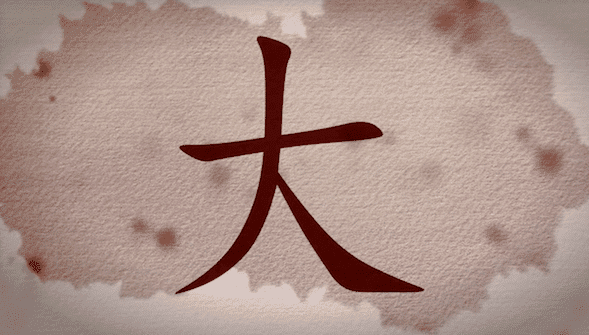This week Nora and Allen look at the 大 character. Watch the video below to see how you can win one of our NEW Written Chinese T-Shirts!
Also, if you can’t access YouTube, you can always watch the video on Youku!
N: Hi everyone, I’m Nora and welcome back to Scavenger Sunday!
A: Hey, don’t you usually speak Chinese?
N: Yeah, but I fancied a change.
A: O.K This time I can speak Chinese. 大家好我是Allen。 欢迎收看我们的节目。
N: This week, we’ve been looking at the character 大!
A: OK, 大 is a pictographic character that means BIG…
A: THIS IS MY 大声!
N: Oh man, I prefer your small voice.
A: Sorry…
N: Anyway, the character 大 can seen almost everywhere in China because “大厦” means big building. It’s easy to recognize because as I demonstrated earlier, it looks like a guy stretching his arms out.
A: You’ll hear 大 being spoken often too. For example often say “欢迎大家收看我们的节目” at the beginning of our video, which means “we welcome everyone to watch our show”.
N: Can you give us some more examples?
A: Yeah, “深圳是个大城市” which means “Shenzhen is a big city”.
N: So let’s take a look at those videos from you this week!
N: Did you see how many “大厦” examples were there?!
A: I did, and I’m glad that many of you are writing the character yourselves!
N: Are you ready for this week’s character?
A: Yeah, what is it?
N: Well, this week we’re going to be looking at 手
A: Oh. 手 commonly means hand and usually we see signs for “洗手间”.
N: Uh oh, does that mean we’re gonna get a lot of toilet pictures this week?!
A: No pictures inside the bathroom please…
N: Alright, Allen. Are you ready to write 手?
A: Yep, let’s go to the board!
A: Ok guys, this week I want to show you how to write the 手 character. 手 is a very common radical, so I think it’s a good character to learn to write. OK, lets get started.
手 has four strokes. The first one is what we call in Chinese: pie, which is a curving radical from right to left. Then the second stroke and the third stroke we say is heng in Chinese, like this. The last stroke is a stroke from top to bottom. OK, that’s the 手 character on the board. Hope you like it.
N: Thanks Allen,
A: It’s my pleasure!
N: We’re looking forward to seeing your 手 pictures and videos that you can upload to www.facebook.com/writtenchinese
A: If you live in China, or see Chinese signs we want those examples too.
N: Video’s would be really cool…and the best video that’s posted to our blog gets a T-shirt!
A: Yeah, maybe someone can send us a video of them writing the 手 character..?
N: Thanks for watching this week’s Scavenger Sunday.
A: 谢谢。。。
N: By the way, if you want to learn a little more about the origins of the 大 character you can read our blog post ‘Chinese Character Stories’ at www.writtenchinese.com/blog
A: Bye for now!
N: 下次见!
A: I thought you weren’t going to speak Chinese…?
N: Oh I changed my mind…
If you want one of our Written Chinese T-shirts please post your videos and pictures of the 手 character on our Facebook page: www.facebook.com/writtenchinese or you can post it on this wall by using the comment are below!
